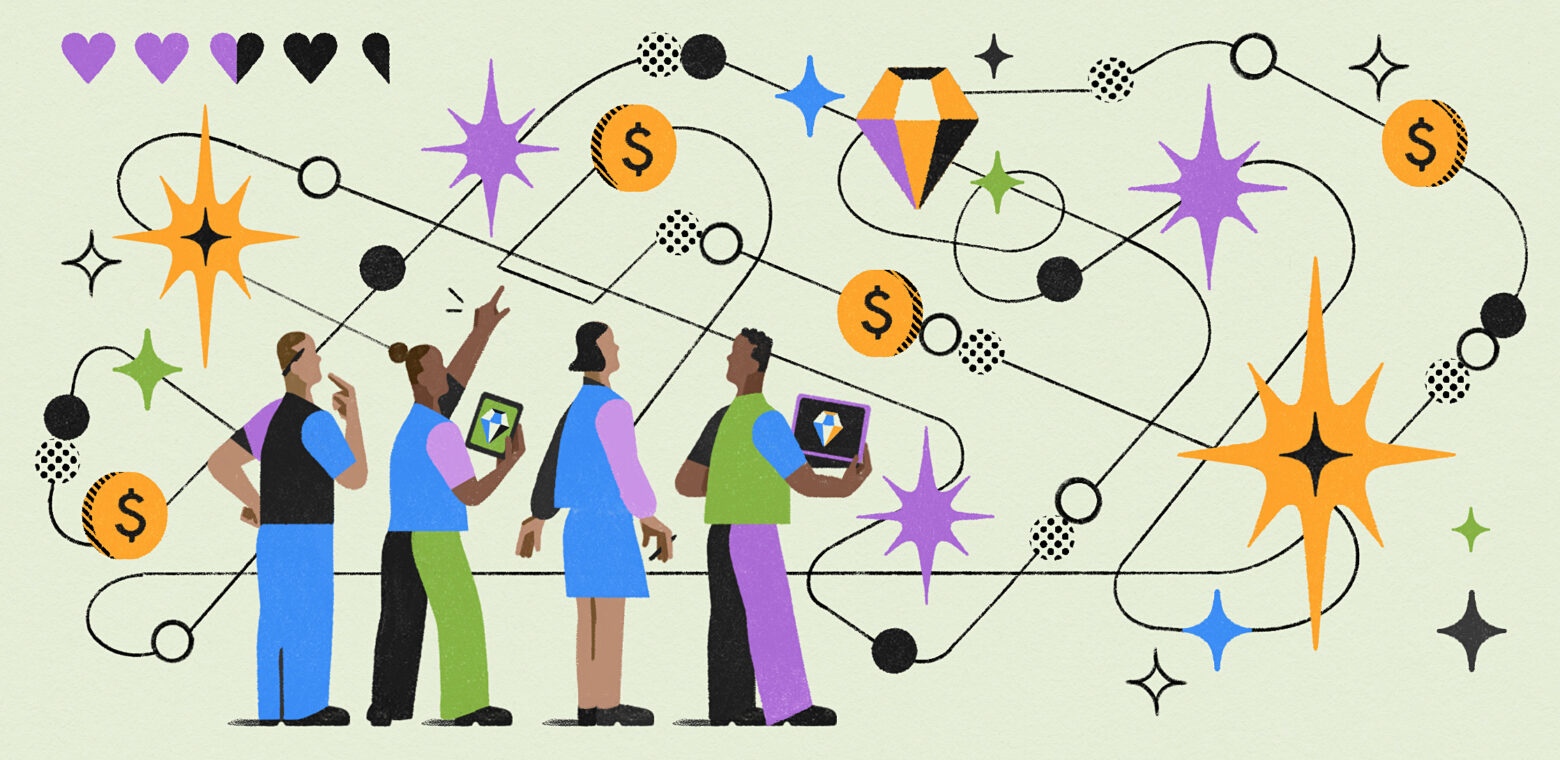A four-generation family reunion; a friends-of-friends gathering; a distributed team of knowledge workers. One thing I’ve seen bring all of these groups together – the most powerful tool in my social kit – Free food. Kidding – games! From cards to charades, the classics to the completely bespoke.
What makes us bond over board games at a bachelorette party can fuel connection to coworkers and our work itself, too. And now’s the time to get creative in how we do it; a recent Gallup study reveals an 11-year low in U.S. employee engagement.
Gamification 101
Something that could help? Free food. JK again – games! And bringing elements of play into our work via gamification.
If you’ve had a conversation about the future of work in the not-so-distant past, gamification has likely entered the chat. It was popularized in product design (think of the app that congratulates you for regular use) and has become trendy in workplace initiatives focused on employee engagement (like bonuses for recommending friends to open roles) and output (think pizza party at the end of a successful sprint).
For Katie Greenman, Founder and CEO of learning design and culture consulting company HumanSide, making work fun is her work. How *does* she do it? “For every learning or culture experience we design, we start by clocking how we get people smiling and laughing. We know that’ll be the superpower and super glue for the rest of the day.”
Having fun at work has been found to positively affect individuals’ creativity, resilience, and social relationships, plus contribute to better engagement in work and reduced employee burnout. Win-win-win.
Employees surveyed in a 2019 study said gamification makes them feel more productive (89%) and happier at work (88%). The reasons why, gamification enthusiasts argue, are rooted in behavioral science. Gamifying parts of our life or work isn’t just fun – it can stoke the ever-dwindling fires of what motivates us:
- Creative problem-solving to reach goals can make us feel autonomous, and more in control of our work destiny.
- When we do good, we feel good. Dopamine is activated in the brain, making that reward system both literal and neurological.
- “Playing” as a team (an Atlassian company value!) drives community and connection as you work together to achieve something.
One of HumanSide’s success stories is with a team of 100 navigating conversations on unconscious bias. And a game that saved them from the dark side: “Two teams nominated someone to compete in a blindfolded inflatable lightsaber competition. Each was guided in (playful) battle by their team’s voices. One participant’s strategy was to crawl, which made everyone laugh. All day, this was referenced with humor as a safe, shared metaphor for different preferences and instincts.
By the end, the team had co-created new strategies with employee-led committees to bring them to life. We’ve seen time and again that if you start with a sense of oneness and joy, it’s a lot easier to end there, too.”
What to be wary of when gamifying at work
Gamification is, despite its moniker, not all fun, nor all games. Rewarding employees solely to get them to work harder may actually have the opposite effect. Enforcing activities on the schedule-stressed can contort fun into what feels like light torture. And micro-managing (quote-unquote) fun can build more resentment than engagement.
“So often we see leadership assigned to come up with creative approaches, but we return to the saying: ‘nothing about us without us,” Katie says. “The best answers and ideas are going to come from the individuals on your team. When gamifying, make sure to align with their goals.”
Katie explains, “For example, we worked with a learning team that launched curriculum to make client meetings more effective, offering incentives to participate. As great as gift cards and free dinners sounded, it trivialized the importance of the curriculum, focusing more on the rewards than educational value.”
Katie’s team helped the group identify a stronger strategy. “Managers identified teammates’ professional goals and how the program could support them, then tailored personal incentives the manager and employee would track and celebrate together. This took more time and energy, but ended up being more effective.”
Fresh ways to gamify your work life
To avoid gamification’s potential to nurture hustle culture over actual culture, consider new ways to implement it on your team. Focus first on a struggle and consider options that’ll turn workplace woes into longer-term wins:
To break through creative blocks…
- Turn ideation into a high-energy event worthy of its own game show jingle with Disruptive Brainstorming. It’ll shake up your team and how you think through ideas to reveal the ultimate prize: a bunch of fresh ideas.
- Host a hackathon! Big or small (Atlassian’s first ShipIt only had 14 participants), it’s a productive way to iterate on issues big or small with an overall mandate to think grandly.
- Or, just play cards; write down your company offerings, the problems you solve, and people you solve them for on index cards. Choose different combos (for example, service + problem to solve + person) at random and pitch solutions.
To find fun in not-so-fun tasks…
- Chip in to get through a backlog, like an Atlassian team that earned poker chips for completed tickets. Teammates paid a “tax” of a weekly chip, and could decide to work on tickets weekly, or whenever they had time.
- Treat yourself to five minutes of whatever lights you up (after 25 minutes of focused work) with the tried-and-true Pomodoro method. I’ve been known to pair the ol’ Pom’ with a puzzle for double the brain stimulation.
- Invite your team to a 100-day challenge to work through a to-do list of their choosing: work or personal, one big task or lots of little things. Encourage accountability with check-ins and a final show and tell.
To strengthen team connections…
- Kick off meetings with creative icebreaker activities to talk about something other than KPIs. And remember: studies support the value of work friends, so don’t hesitate to wade into those watercooler convo follow-ups.
- Make your next Lunch and Learn about each other with psychotherapist Esther Perel’s delightfully designed Where Should We Begin, which is perfect for game night with friends and SFW team bonding alike.
- Connect over trivia, whether to get to know each other or your company better. Rethink classic categories: company history, most-clicked articles, chronology of product releases, matching coworkers to their baby pic – the possibilities are endless.
To help employees feel more engaged…
- Cozy up to your customers through Empathy Mapping and a little role playing. If you don’t have customer interviews to guide your map with specifics, turn this into a storytelling exercise and put a lil D+D in your R+D.
- Give your team creative license and an invite to manage a piece of the play with an Olympics-style day. Participants come with their own work-themed event to host that can be played in under 10 minutes.
Connect back to who and what your company is with a program that encourages walking the walk. Take Atlassian’s Community Kudos program, participation in the Atlassian Community earns points, badges, and prizes.
Gamification in action: the Atlassian Community Kudos Program
The Atlassian Community’s Bite- Sized Learning Series pairs up short videos with quizzes on topics ranging from Confluence keyboard shortcuts to Atlassian AI, and rewards users with Kudos. Over 2,000 users have taken our quizzes in the first six months of the program.
In another activation aimed at planting trees and the seeds of online engagement, the team encouraged users to “Like” community content. For each click that month, a tree was planted via Eden Reforestation Projects.
- A win for members: Users discovered new content, posting and liking tree trivia and gifs as they pitched in for the planet.
- A win for converting engagement: Anonymous users who saw the aptly-named Likes for Trees experiment were 2.4x more likely to engage in the online community.
- A win for the planet: As a result of the campaign, 72,425 trees are being planted around the world!
Atlassian Community Senior Manager Monique van den Berg says, “Likes for Trees has been such an engaging community-builder, allowing users to take direct action that underscores Atlassian’s commitment to the planet. The Atlassian Foundation has matched our tree-planting each year, and we’re excited to expand our efforts in summer 2024, rewarding users not only for liking content but also for RSVPing to community events, learning with Atlassian University, and more.”
Make workplace gamification meaningful
Like any good gamer, you’ve now read up on “how to play” and are ready to get started. But before you go forth and gamify, keep the following in mind:
Do: Less managing, more cultivating. Especially if you’re already in a leadership role, try activities teammates can take the lead on.
Do: Think long term, looking for play to inspire new ways of working or solutions to move you and your crew past a slump.
Do: Prioritize collaboration over competition to avoid pitting teammates against each other or favoring certain personality types.
Do: Save time instead of adding it. Especially for backlogged teams, aim for games ultimately meant to free up their schedules.
Do: Aim for authenticity. A tip from Katie and team is to avoid anything that feels, well, cringe. “Thankfully, on the opposite side of forced and inauthentic, is contagious enthusiasm and joy.”
In gamification at work, it’s not about winning or losing, but how you and your team move past “Go.” And then keep going. The real rewards come from nurturing those leaderboards that exist internally, helping us to reach our own goals and level up on motivation. Having a bit of fun doing it doesn’t hurt.













































